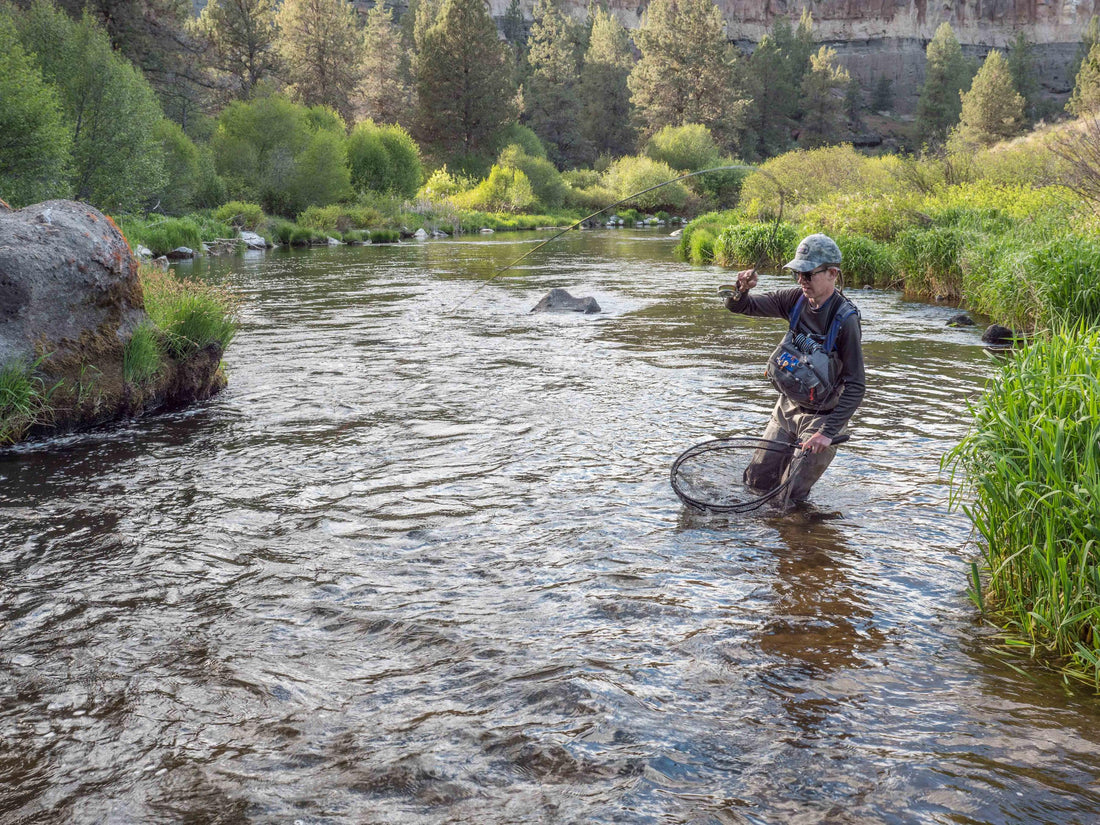
When the going gets tough, fish tight.
Share
Back in late May before I left Oregon, I had the chance to wake up well before dawn and drive from Grant's Pass over to Bend to fish with Joey Pattee and Eduardo Gonzalez Ferreiro. Joey was training before heading to the US Youth Fly Fishing Team national championship and was hoping Eduardo and I could lend a little advice on the water.
We fished a section of river that was flowing at a trickle as a result of upstream diversions. Throughout the day we caught good numbers of mostly small fish. Earlier was better as the day was hot and the small volume of sun baked water climbed from 55 degrees in the morning to 66 degrees in the afternoon. While 66 degrees isn't at a stress level for trout, a swing in temperature that large often results in poor fishing as the trout deal with the shock to their metabolic system.

A typical small brown for the river landed by Eduardo.
The last section of water we fished was stingy with its offerings and the fish were few and far between. However, most of what we had covered was shallow pocketwater so I thought our fortunes would change when we came to a big pool with a car sized boulder in it. Joey and I took turns fishing in it. All we managed from the tailout to the shelf at the head were a few peamouth chubs. We tried alternating between dry dropper and Euro nymphing to cover any and all holding spots that might potentially hold a willing fish.
It was getting late and we were nearing time to go as I neared the top of the run coming into the pool. I thought that with the warm temperatures a few aggressive fish might have slid into the aerated faster water at the lip of the shelf. Still I had no success and I just wanted to get a fish to end on. As I was lamenting my current state of affairs a bit I turned my head downstream and saw Joey's rod doubled over on what looked like a sizable fish. I snapped a few shots of the fight and then ventured downstream to see what he had tangled with. It ended up being the largest trout of the day, a brown in the 16-17" range that was a fine fish for that piece of water.


Joey's brown.
I asked Joey where he had caught the fish and he told me his flies had been nearly scraping the front of the large midstream boulder when it ate. I had to eat a slice of humble pie since I had already fished through the area. However, there was a significant current undertow in the run coming into the pool that slid flies in the drift laterally to the river right side back toward the angler. Though I had made some casts aimed at getting my flies to the front of the rock, I never had one that fully got to my intended target on the front of the rock because of the lateral drift. I was within a foot of the rock in about 10 or so drifts but that brown clearly wasn't willing to move from its lie to eat in the warm low water. Because he had cast a bit further across the river and closer to the rock, Joey was able to get his flies to drift within inches of the front of the rock. The tight proximity sealed the deal and capped off a slow end to a fun day.
Joey's success forced me to relearn a lesson I've had to learn many times before. There have been times I've fished an area thinking that I have fished tight enough to the structure to show my flies to any willing fish, yet no fish have come to the net. When the water is in prime shape and the fish are on the feed, they are often willing to move a fair distance for flies and drifts through likely looking spots will bring fish to your flies even though they may be holding tight to nearby structure. My trip on a local river today was the perfect example as the high cool water had the fish active and willing to eat and drifts through obvious seams and slicks resulted in an abundance of fish. However, when the water drops and the fish feel exposed, it is often necessary to fish much tighter to structure to entice a take. Many times this results in snags and lost flies. A lot of anglers are unwilling to risk losing their flies repeatedly or they simply haven't developed the accuracy necessary to put their rigs into tight spots. Furthermore, when fishing indicator rigs, flies will often be pulled away from intended structure when the indicator lands in a current seam that is different than the seam the flies land in or the seam where the intended drift is to be made.
When fish are in refuge mode, you may need to place your flies literally on rocks or back under trees to get willing eats. During practice for last year's World Fly Fishing Championship in Colorado, I watched my teammate Pat Weiss catch fish completely under the edges of rocks. Pat is a master at this type of fishing and the fish he caught were often much darker than the fish in more open water which showed they had been living in hiding under the rocks for a while and adapting their skin color to camouflage to their surroundings. When I came to a very difficult beat in skinny water on the lower Eagle River in the championship (read this blog for the recap), the only way I was able to catch fish was to scrape them on rocks and fish them under logs. Through most of the session I told myself to channel my inner Pat Weiss.
The next time you are on the river and you are struggling to catch fish. First, take a look at your drifts, presentations, weight, rigging, etc. If you truly feel you are making good presentations, you may simply just not be getting your flies close enough to fish. Take stock of the structure in the river around you. Find ways to get your flies as close to each rock, log, and other holding lies that you find. Be willing to lose flies or at least blow up a spot because you have to go in and retrieve your flies from a snag. These types of places gather all manner of sticks and potential fly thieves but those same snags are the very reason trout feel secure living there. If you are willing to take risks putting your flies tight to structure and if you've developed the casting and presentation skills to reliably fish them there, you will be able to counter the odds and put more fish in the net than you might have thought possible even in tough conditions. Remember, when the going gets tough, fish tight.
Happy Fishing,
Devin
